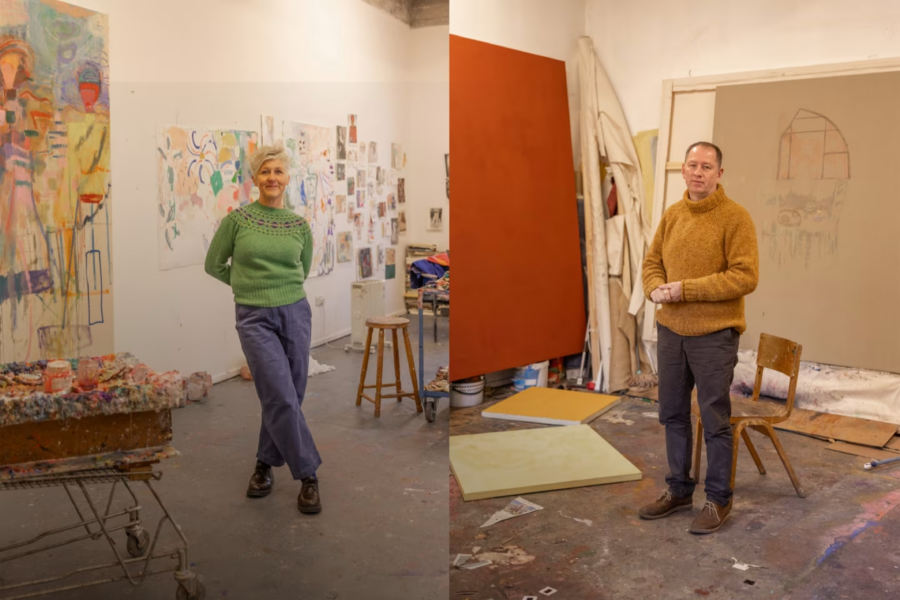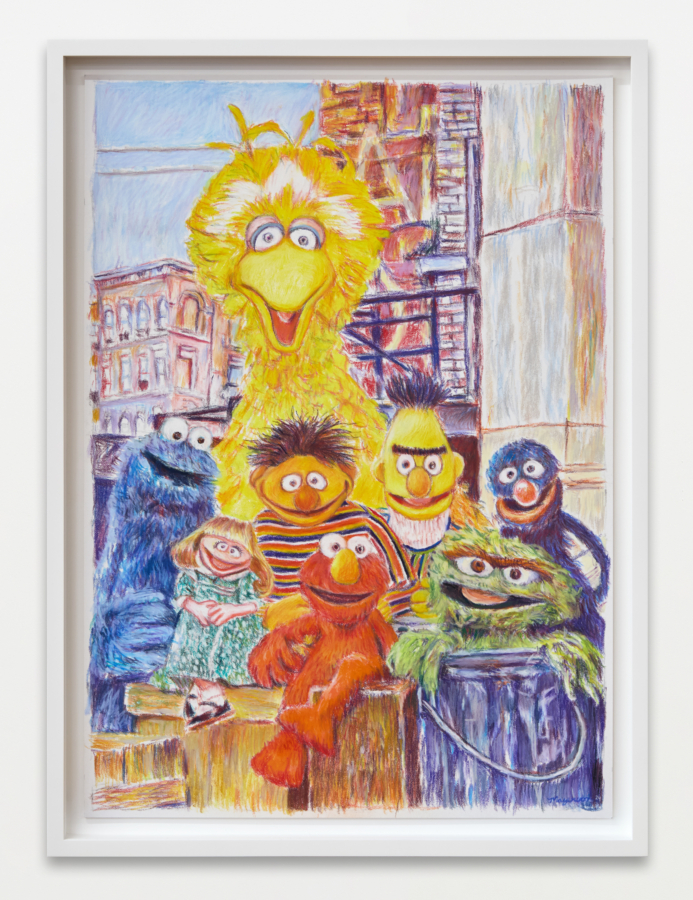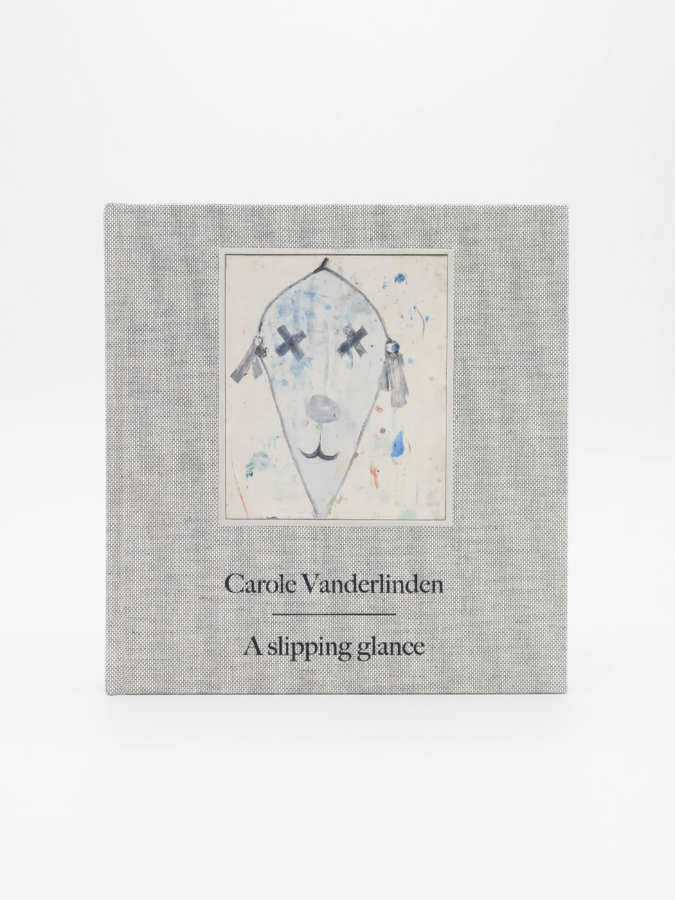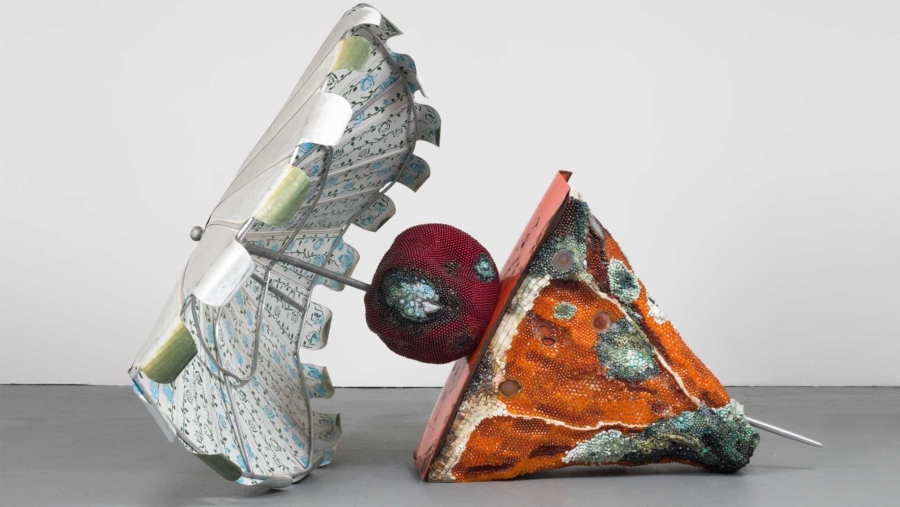January 24, 2024

Photography by Richard Gaston
Andrew Cranston and his partner Lorna Robertson paint in adjoining studios separated by a bare concrete wall. North light filters through high windows at the back of the building on the river Clyde in Glasgow – a steady light that does not streak like the southern sun. It is rather grey, but good, Cranston says, for the unhurriedness that both artists need.
Standing in his studio’s symphonic arrangement of calico scraps, spineless old books, saucepans (used for canvas bleaching), bright stalagmites of paint, and an oil‑smeared kettle whistling to the boil, Cranston looks upward to the 12ft ceiling. “I always think the space above your head is really important, in some unconscious way.” Painting in a low-ceilinged room is hard, he says. Carpets are a no-no too. He and Robertson laugh fearfully at the thought.
The familial themes in both Cranston and Robertson’s work – playing upon memory, and layers of time – have required a patience that has now brought the couple into a rare late art-world bloom in their 50s. Cranston, who grew up in Hawick in the Scottish Borders, and Robertston, whose childhood home sat on Prestwick’s seafront, on the Ayrshire coast, met in a different studio in Glasgow almost three decades ago. They wooed each other over Nick Drake songs and east-to-west nightwalks through the city, which has a vivid art scene whose inner circles they have always stayed shy of. Glasgow instead appears fondly in Cranston’s work in glimpses of tenement rooms and views through windows, radiating his ability to capture the emotional density of lived-in spaces. As parents to three children, they spent years painting and quietly teaching art – “skint” for a while, until finally their work seemed to be visible at the right tide.
Cranston’s first solo public institution exhibition, What made you stop here?, which opened at Yorkshire’s Hepworth Wakefield in November 2023, followed a successful solo show at the influential Karma gallery in New York’s East Village in 2021; new work is planned for the gallery’s Los Angeles sibling this coming July. Brendan Dugan, the founder of Karma, first saw Cranston’s work when White Columns gallery director Matthew Higgs included it in Outside, a group exhibition he curated for Karma in 2016. “I was immediately struck by Andrew’s ability to combine storytelling and surreal humour,” he says.
Robertson, meanwhile, had a well-received solo booth at 2023’s Armory Show art fair in New York and will have a London show in May at Alison Jacques on Cork Street. Both are represented by and have shown at Ingleby Gallery in Edinburgh. Richard Ingleby, its owner, says finished works by Robertson now fetch between £10,000 and £60,000, while Cranston’s pieces command between £20,000 and £120,000, depending on scale. “When you start making money you’re seen completely differently,” Robertson says. “But for me and Andy, we were defined by the 25 years that we weren’t that successful.”
Robertson works in studio 218, Cranston 219 – but the partners are not even and odd in style, they say, but rather comfortably different. They each enjoy a “communion with the self”, Cranston says, chuckling at how lofty this sounds, but then they come together for tea breaks around 219’s oil radiator, discussing each other’s troubles and swapping paints. (They have just come back with a suitcase-full from the art supplier Sennelier on Quai Voltaire, after seeing the Mark Rothko exhibition at Fondation Louis Vuitton in Paris.) Over the years they have learnt to handle time better, understanding their personal work rhythms. Robertson relishes autumn for its exciting quality of light: “I know I’ll get lots of work done.” Cranston says he thinks more visually as the day goes on, which makes it “hard to leave the studio sometimes”.
Some of the unfinished canvases propped up against their studio walls have been there for years, waiting for answers. And some may eventually be discarded. “Disasters are OK,” Robertson says. “I need disasters to get to the right place. Without the mess I’ll not get to the end. You understand the pattern you need to get to.” Cranston shares this attitude. “Sometimes you almost have to trick yourself into making the work. Before you know it, you have something in front of you. It’s a funny mix of patience and urgency. Playfulness is an important instinct to keep as an artist,” he says.
Laura Smith, director of collections and exhibitions at The Hepworth Wakefield, says Cranston’s work has a “depth of space and generosity of materials. There’s a lusciousness to his use of oil paint and varnish.” Cranston often uses old-fashioned distemper with rabbit‑skin glue as primer, followed by pigment, which gives some of the works a textural shimmer. Other canvases are coloured with domestic dyes, producing a melancholy fade to the surface. His work has a dreamlike warmth but also a confounding privacy in which the subjects often face away from the viewer, seeing something elusive.
One work in progress, an eerie black-beamed house in the Scottish Borders that Cranston remembers from a postcard, shows wind turbines turning on a distant hilltop, but Cranston is considering painting them out (“I’m wondering about them”). The postcard had belonged to Robertson, who had already painted from it herself. Another of his huge, half-begun canvases has a warm go-to-bed candle flame at its centre, and little else yet. Shelves of hardbacked books from Glasgow’s legendary second-hand bookshops Voltaire & Rousseau (where Robertson also gets materials from house clearances) and Caledonia Books are left open and turned into canvases – a technique Cranston is known for.
Next door, Robertson has a trolley strewn with opened paint tubes (“I never put the lids back on. Andy does”) and a cabinet for her stash of magazines and clippings that she applies to canvas, juxtaposed against dissonant painted forms. “Collage gives me a tension,” she says. “Something to play against, a sharp note against a soft note.”
Her room is neat, and she comes to it daily from swimming at the Arlington Baths Club in the city where the lengths help to clear her mind, she says. Lately, her work has become larger and blowsier in colour, as if it is painted toward some inner freedom. She has always worked on both the wall and the floor, and is more recently influenced by watercolour than oils. “A painting is a kind of space where you can stay. Somewhere you can go, similar to a piece of music,” she says. “Paintings take away the weight of words. I enjoy the silence of paintings. I want them to be open.”
Robertson says she also draws at night in bed, a habit developed when her brother died suddenly some years ago, and she found herself sleepless with grief. “I needed drawings to survive. They’re a reminder of how strange things can get. Just pencil, pen and paper… The work keeps developing as I change.” Meanwhile, every time he has a bath, Cranston says he thinks of Pierre Bonnard. The post-impressionists, who captured the lushness of differing lights and domestic rituals, have a kind of filmy presence in his work. Bonnard’s sense of space and “all over surface” are a particular inspiration. “I liked the sense that the Bonnards are never finished,” he says. Henri Matisse, Édouard Vuillard and their peers were a big influence on Scottish painting more generally, he adds. French-tinged work by another Hawick painter, Anne Redpath, was “kicking around the town”, in his line of sight at the museum and library. As a young artist, he also won bursaries to Florence and Vienna, where he “took so much from the quieter moments. When it’s just a [painting of a] table with loaves and cups, or someone putting on a jumper.”
Robertson also won a scholarship to Florence, and came back with a trust in a “language of paint; you really felt how much Fra Angelico believed in God”. The freedom in being an artist, Robertson says, is what she finds most exciting. Painting is “knowing there’s things you want to do. But I never go about with huge plans.”
This links to Cranston’s interest in what he calls “creative misremembering”, that there is material – experience and emotion – to work through on canvas, but exactitude is not necessarily the aim. The first painting at the Hepworth Wakefield show is of a boy staring at a model ship in a glass case. It is a memory of taking their children to the old Glasgow Museum of Transport. “It came back to me. I like remembering something that’s gone, and trying to get back to it.”
Robertson, too, finds the past travelling into her work by strange routes. A childhood friend wrote to her out of the blue, saying she’d seen a painting of hers that made her think of the house Robertson’s family lived in by the sea in Prestwick, an allusion that Robertson hadn’t consciously intended. “I found that so exciting. It was reassuring that there was some language there she connected to. Maybe I am using things from my past – I am not nostalgic, but it’s a past I’m not aware of. There’s always something of your past that’s there.”



